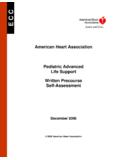Transcription of PALS 2006 Written Precourse Self-Assessment
1 E C C American Heart Association Pediatric Advanced Life Support Written Precourse Self-Assessment December 2006 2006 American Heart Association PALS Written 2006 Precourse Self-Assessment 2 2006 American Heart Association PALS Written 2006 Precourse Self-Assessment ECG Rhythm Identification The PALS Self-Assessment on ECG rhythm identification is designed to test your ability to identify rhythms you may encounter as a PALS provider. The rhythms listed below in boldface type are the core PALS rhythms that you should be able to identify during the PALS Provider Course teaching and testing stations.
2 If you have difficulty with pediatric ECG rhythm identification, we strongly suggest that you spend additional time reviewing basic pediatric arrhythmias before the PALS Provider Course. Sources of information about pediatric ECG rhythm identification include the ECG Basics section of the student CD, the PALS Course Guide, and the PALS Provider Manual. The rhythm identification Self-Assessment has 13 multiple choice questions. Questions 1 to 8 cover the core PALS rhythms (see rhythms in boldface below). Questions 9 to 13 contain advanced material that you don t have to know before the PALS course but that may be useful to your clinical practice. For all questions select the single best answer (ie, rhythm) from the list of 14 rhythms (A to M) below.
3 A question may have more than one correct answer. Annotated answers that explain both correct and incorrect answer selections are located at the end of the self -assessments. The ECG Basics sections of the student CD and other sources of information are given in the annotations. There are 3 Self-Assessment tests: ECG Rhythm Identification, Pharmacology, and Practical Application. Pediatric Rhythms (core PALS rhythms A to H; non-core rhythms I to M): A. Normal sinus rhythm B. Sinus tachycardia C. Sinus bradycardia D. Supraventricular tachycardia (SVT) E. Wide-complex tachycardia; presumed ventricular tachycardia (monomorphic) F. Ventricular fibrillation (VF) G. Asystole H. Pulseless electrical activity (PEA) I.
4 SVT converting to sinus rhythm with adenosine administration J. Wide-complex tachycardia (in a child with known aberrant intraventricular conduction; this is SVT with aberrant conduction) K. First-degree AV block L. Torsades de pointes (polymorphic ventricular tachycardia) M. VF converted to organized rhythm after successful shock delivery (defibrillation) Rhythms 1 to 8: Core PALS Rhythms (select single best answer from rhythms A to H) PALS Written 2006 Precourse Self-Assessment 3 2006 American Heart Association Rhythm 1 (clinical clue: heart rate 214/min) For further information: see the PALS Provider Manual Chapter 6: Recognition and Management of Bradyarrhythmias and Tachyarrhythmias and Chapter 7: Recognition and Management of Cardiac Arrest.
5 Rhythm 2 (clinical clues: heart rate 44/min; no detectable pulses) For further information: see the PALS Provider Manual Chapter 6: Recognition and Management of Bradyarrhythmias and Tachyarrhythmias. Rhythm 3 (clinical clues: age 8 years; heart rate 50/min) For further information: see the PALS Provider Manual Chapter 6: Recognition and Management of Bradyarrhythmias and Tachyarrhythmias. PALS Written 2006 Precourse Self-Assessment 4 2006 American Heart Association Rhythm 4 (clinical clue: no detectable pulses) For further information: see the PALS Provider Manual Chapter 7: Recognition and Management of Cardiac Arrest.
6 Rhythm 5 (clinical clue: no consistent heart rate detected; no detectable pulses) For further information: see the PALS Provider Manual Chapter 7: Recognition and Management of Cardiac Arrest. PALS Written 2006 Precourse Self-Assessment 5 2006 American Heart Association Rhythm 6 (clinical clues: age 3 years; heart rate 188/min) For further information: see the PALS Provider Manual Chapter 6: Recognition and Management of Bradyarrhythmias and Tachyarrhythmias. Rhythm 7 (clinical clue: heart rate 300/min) For further information: see the PALS Provider Manual Chapter 6: Recognition and Management of Bradyarrhythmias and Tachyarrhythmias.
7 PALS Written 2006 Precourse Self-Assessment 6 2006 American Heart Association Rhythm 8 (clinical clues: age 8 years; heart rate 75/min) Rhythms 9 to 13: Non-core Rhythms Rhythm 9 (clinical clue: initial rhythm associated with no detectable pulses) For further information: see PALS Provider Manual Chapter 7: Recognition and Management of Cardiac Arrest PALS Written 2006 Precourse Self-Assessment 7 2006 American Heart Association Rhythm 10 (clinical clues: age 9 months; heart rate 38/min) For further information: see the PALS Provider Manual Chapter 6: Recognition and Management of Bradyarrhythmias and Tachyarrhythmias.
8 Rhythm 11 (clinical clues: heart rate 200/min; no detectable pulses) For further information: see the PALS Provider Manual Chapter 6: Recognition and Management of Bradyarrhythmias and Tachyarrhythmias and Chapter 7: Recognition and Management of Cardiac Arrest. PALS Written 2006 Precourse Self-Assessment 8 2006 American Heart Association Rhythm 12 (clinical clue: heart rate 150/min) For further information: see the PALS Provider Manual Chapter 6: Recognition and Management of Bradyarrhythmias and Tachyarrhythmias. Rhythm 13 (clinical clue: initial rhythm associated with heart rate 300/min) For further information: see the PALS Provider Manual Chapter 6: Recognition and Management of Bradyarrhythmias and Tachyarrhythmias.
9 Drug administered PALS Written 2006 Precourse Self-Assessment 9 2006 American Heart Association PALS Written 2006 Precourse Self-Assessment Pharmacology The PALS Pharmacology Self-Assessment is designed to test your knowledge of core drugs that will be used in the PALS Provider Course. This drug knowledge includes the indications, contraindications, and methods for administration of these agents. This exercise tests your ability to correctly use these drugs in scenarios similar to those you are likely to encounter in the PALS Provider Course teaching and testing stations.
10 The stations are designed to simulate the knowledge you will need to care for seriously ill or injured children. If this Self-Assessment shows that your knowledge of the pharmacology and indications for these drugs is deficient, we strongly suggest that you spend additional time reviewing basic resuscitation drug pharmacology before taking a PALS course. Sources of PALS drug information include the student CD, the PALS Course Guide, the PALS Provider Manual, and the Handbook of Emergency Cardiovascular Care (ECC Handbook). The Pharmacology Self-Assessment consists of 11 multiple choice questions. Select the single best answer. Annotated answers that explain both correct and incorrect answer selections are located at the end of the self -assessments.


